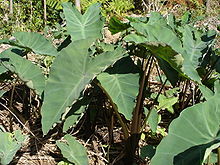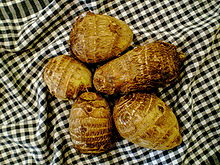- Colocasia esculenta
-
Colocasia esculenta Scientific classification Kingdom: Plantae (unranked): Angiosperms (unranked): Monocots Order: Alismatales Family: Araceae Subfamily: Aroideae Tribe: Colocasiodeae Genus: Colocasia Species: C. esculenta Binomial name Colocasia esculenta
(L.) SchottColocasia esculenta is a tropical plant grown primarily for its edible corms, the root vegetables whose many names include Taro and Eddoe. It is believed to be one of the earliest cultivated plants.[1]
Contents
Description
Rhizomes of different shapes and sizes. Leaves up to 40×24.8 cm, sprouts from rhizome, dark green above and light green beneath, triangular-ovate, sub-rounded and mucronate at apex, tip of the basal lobes rounded or sub-rounded. Petiole 0.8 -1.2 m high. Spathe up to 25 cm long. Spadix about 3/5 as long as the spathe, flowering parts up to 8 mm in diameter. Female portion at the fertile ovaries intermixed with sterile white ones. Neuters above the females, rhomboid or irregular oblong. Male portion above the neuter. Synandrium lobed, cells 6 or 8. Appendage shorter than the male portion.
Taxonomy
The specific epithet means "edible" in Latin.
Taro is closely related to Xanthosoma and Caladium, plants commonly grown as ornamentals, and like them it is sometimes loosely called elephant ear.
Distribution and habitat
Taro was probably first native to the lowland wetlands of Malaysia (taloes). Estimates are that taro was in cultivation in wet tropical India before 5000 BC, presumably coming from Malaysia, and from India further transported westward to ancient Egypt, where it was described by Greek and Roman historians as an important crop. In India, it is known as "arbi" or "arvi". In Indonesia, it is called talas or keladi.
In Australia, Kimberley region of Western Australia; variety esculenta is naturalised in Western Australia, the Northern Territory, Queensland and New South Wales.
Uses
Main articles: Taro and EddoeTaro's primary use is the consumption of its edible corm and leaves. In its raw form, the plant is toxic due to the presence of calcium oxalate,[2][3] and the presence of needle-shaped raphides in the plant cells. However, the toxin can be destroyed and the tuber rendered palatable by cooking,[4] or by steeping in cold water overnight.
Corms of the small round variety are peeled and boiled, sold either frozen, bagged in its own liquids, or canned. The leaves are rich in vitamins and minerals.
It is also sold as an ornamental aquatic plant.
See also
- Taro
- Aquatic plants
References
- ^ Country profile: Samoa, New Agriculturist Online new-agri.co, accessed June 12, 2006
- ^ Weird Foods from around the World
- ^ ASPCA: Animal Poison Control Center: Toxic Plant List
- ^ The Morton Arboretum Quarterly, Morton Arboretum/University of California, 1965, p. 36.
Categories:- Araceae
- Edible plants
- Crops originating from Asia
- Flora of Southeast Asia
- Flora of Indochina
- Flora of Indomalesia
- Flora of Hong Kong
- Flora of the Maldives
- Angiosperms of Western Australia
- Flora naturalised in Australia
- Monocots of Australia
- Garden plants of Asia
Wikimedia Foundation. 2010.


